TABLE OF CONTENTS
Smoking weed can produce blissful, euphoric, and relaxing feelings but also comes with a few mild side effects, including dry mouth and red eyes. If you’re looking for redness relief check out our top picks for best eye drops for stoners.
*If you make a purchase of any of these stoner eye drops we might make a tiny bit of money from Amazon, so thanks!
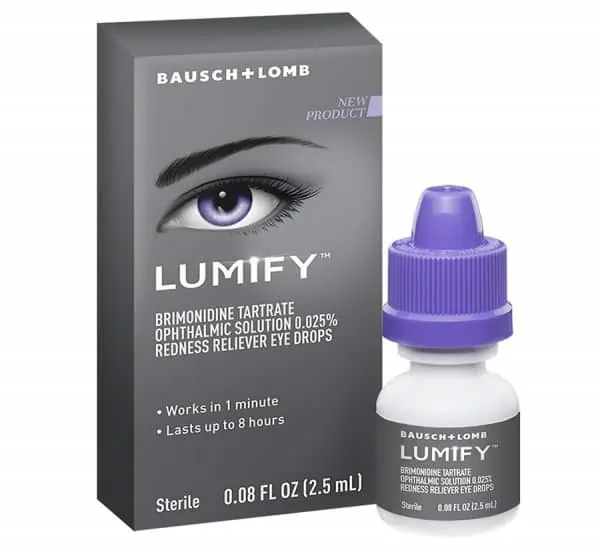
Lumify Redness Reliever Eye Drops
For serious redness relief, the Lumify Redness Reliever Eye Drops are the gold standard for stoners. While you can buy them over the counter, it is the only OTC product that contains brimonidine, the active ingredient that relieves red eyes, without the potential side effects of other eye drop products.
A single drop in each eye can get rid of redness in under one minute, and the effects can last for up to eight hours. These eye drops are FDA approved, contain no bleach or dyes, and are a surefire way to get rid of bloodshot eyes.
- Fast-acting
- Long-lasting (up to eight hours of relief)
- Low risk of side effects
- Requires only one drop per eye
- Not recommended for long-term use
- Long-term use may lead to eye irritation
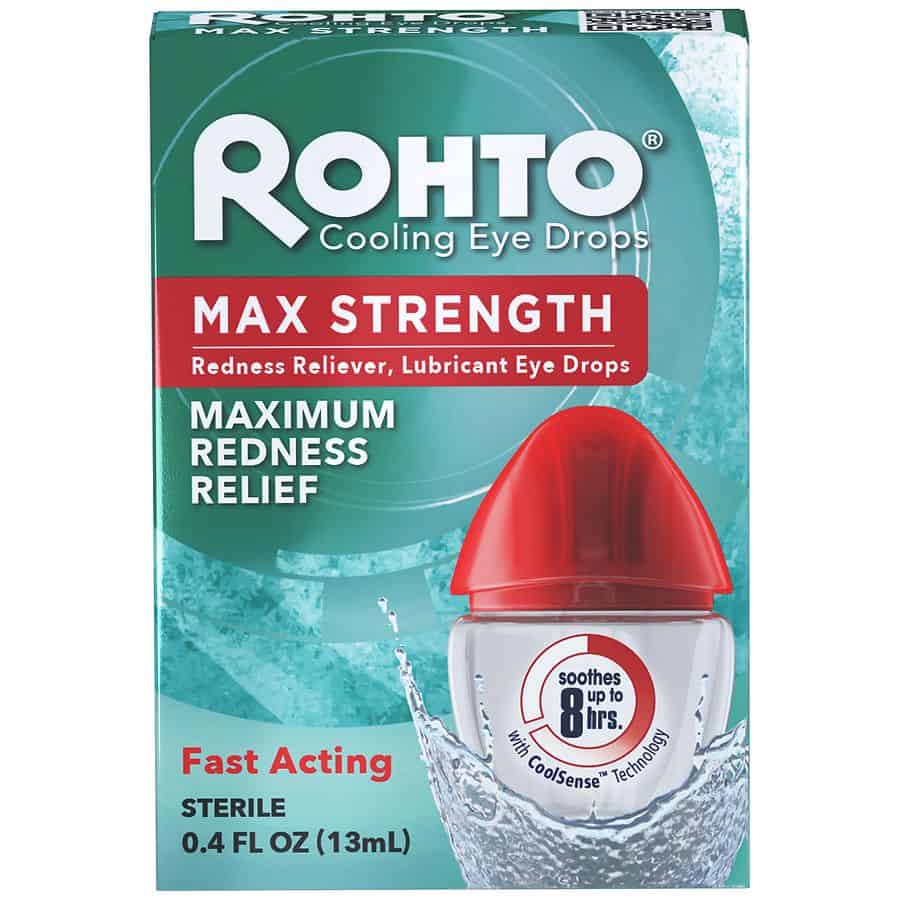
Rohto Maximum Redness Relief
Kiss red eyes goodbye with the number one global OTC eye care brand. The Rohto Maximum Redness Relief eye drops are among the best eye drops for stoners.
Just one drop per eye provides nearly instant relief of red and irritated eyes for up to eight hours after smoking pot. A cooling sensation reduces irritation and gives you clear eyes.
- Fast-acting
- Long-lasting (up to eight hours of relief)
- Cooling sensation to relieve irritation
- Active ingredients can cause irritation
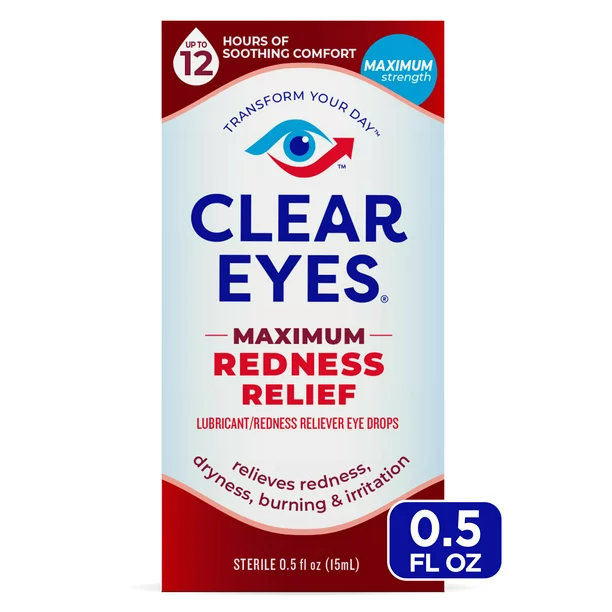
Clear Eyes Maximum Redness Relief
Clear Eyes produces some of the best eye drops on the market. Experience fast-acting and powerful redness relief for up to 12 hours. While they may not work for some users, these affordable eye drops can relieve eye dryness, burning, and irritation.
- Affordable
- Fast-acting
- Long-lasting (up to 12 hours of relief)
- May not provide sufficient eye relief for some
- Not as quick-acting as other eye drops
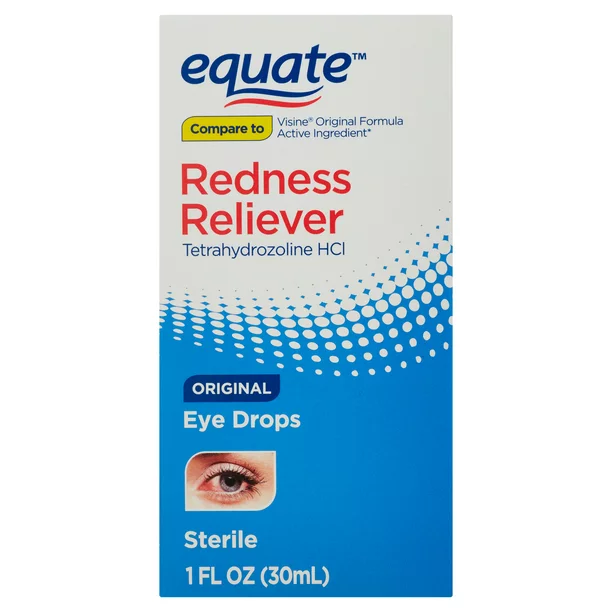
Equate Redness Reliever Eye Drops
If you're looking for an affordable eye drop solution, look no further than the Equate Redness Reliever Sterile Eye Drops. Stock up on the three-pack to reduce redness and dryness as well as itchiness from the weed smoke.
These eye drops feature tetrahydrozoline hydrochloride, an active ingredient used to relieve redness, commonly found in higher-priced eye drops, although it comes in lower concentrations in this product.
- Affordable
- Quick-acting
- Comes in three-pack
- Relieves redness, itchiness, and dryness
- May irritate eyes
- May increase redness
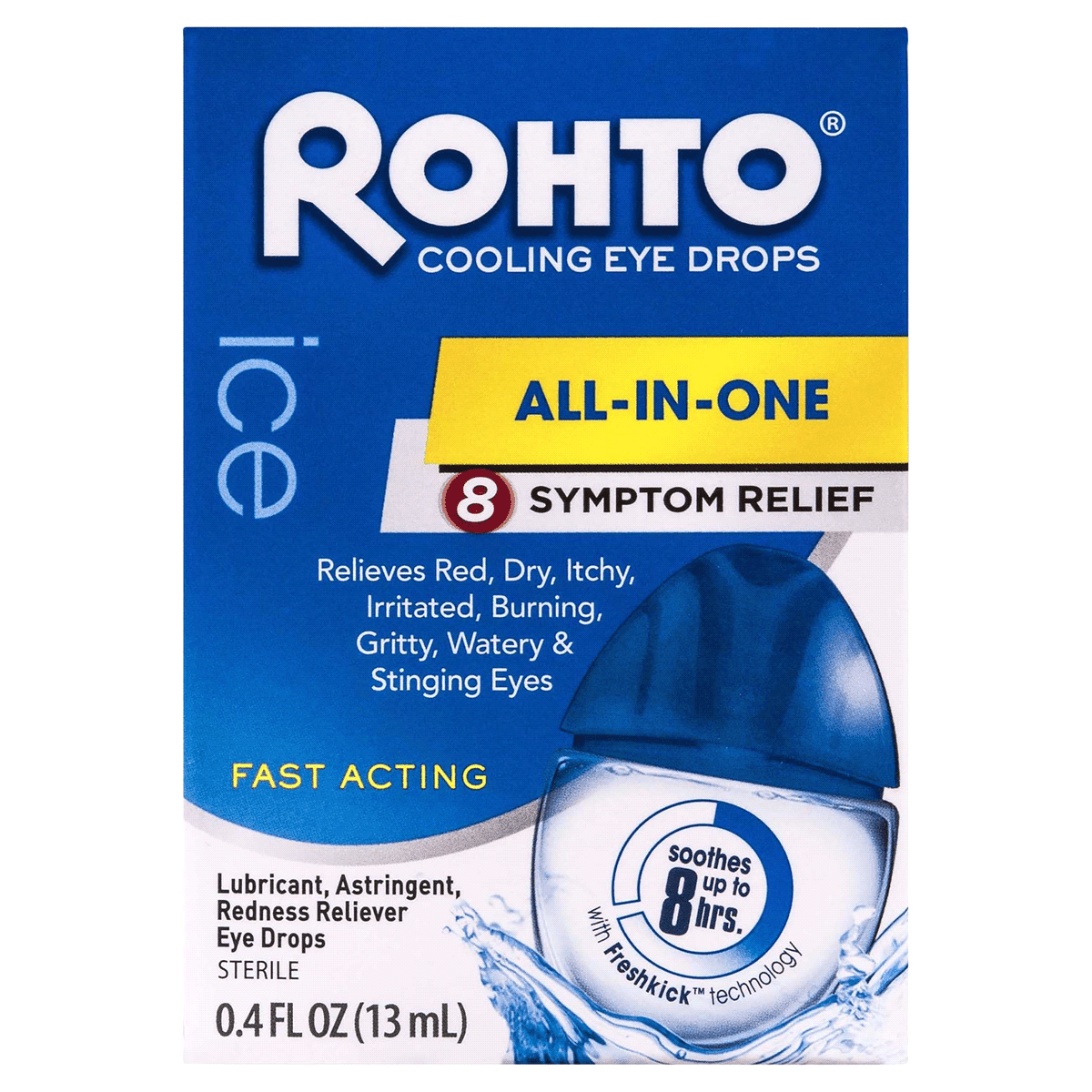
Rohto Ice All-In-One Multi-Symptom Relief Cooling Eye Drops
If you're battling against a wide range of eye issues from weed or other irritants, the Rohto Ice Multi-Symptom Relief Cooling Eye Drops is an all-in-one package. These cooling lubricant eye drops can relieve itchiness, burning, redness, all while hydrating dry eyes.
Whether you're sitting long hours in front of the computer or just got done smoking weed, one or two drops of these eye drops can provide dry eye relief for up to 12 hours.
- Requires one to two drops
- Long-lasting ( up to 12 hours of relief)
- Fast-acting
- Relieves multiple symptoms
- Some users don’t like the cooling effect
- May cause further irritations
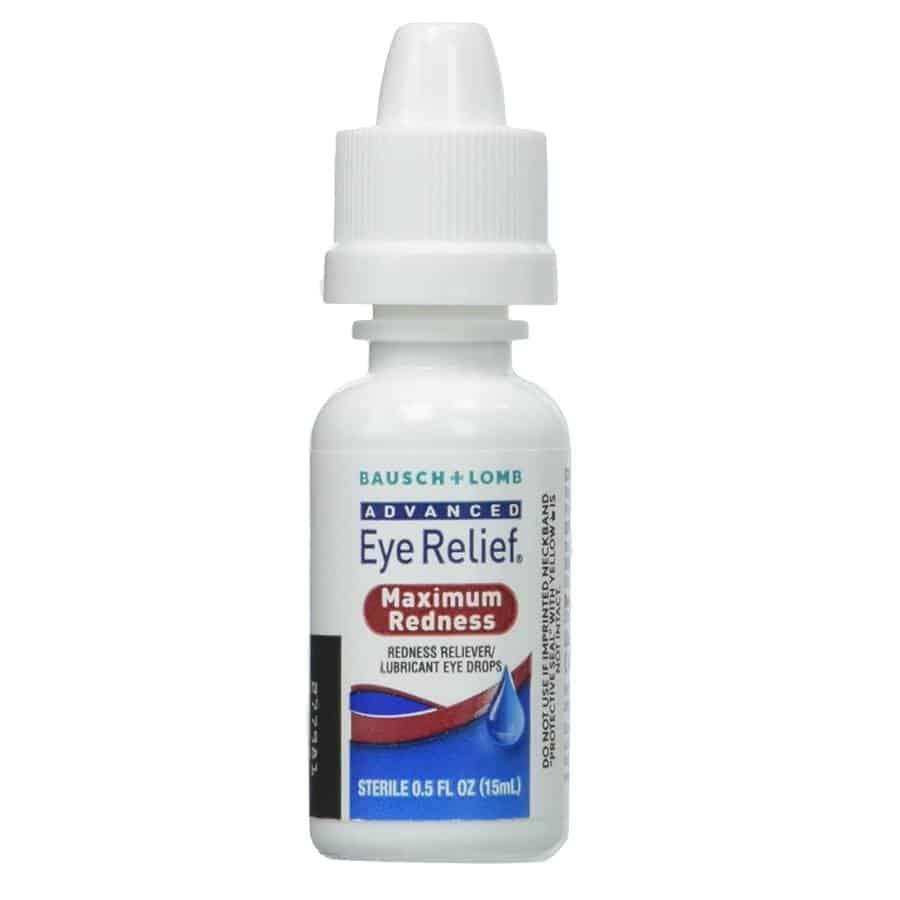
Bausch + Lomb Advanced Eye Relief Maximum Redness
For ultra-strength redness relief, go with the Bausch + Lomb Advanced Eye Relief Maximum Redness eye drops. These eye drops help moisturize your eyes and provide temporary relief for red and irritated eyes.
Whether your eyes are red and dry due to wind, sun, or weed exposure, these eye drops contain 0.03% naphazoline hydrochloride, an active ingredient used to relieve red eyes.
- Strong medicinal relief
- Affordable
- Long-lasting
- Applying too many drops can cause redness and irritation
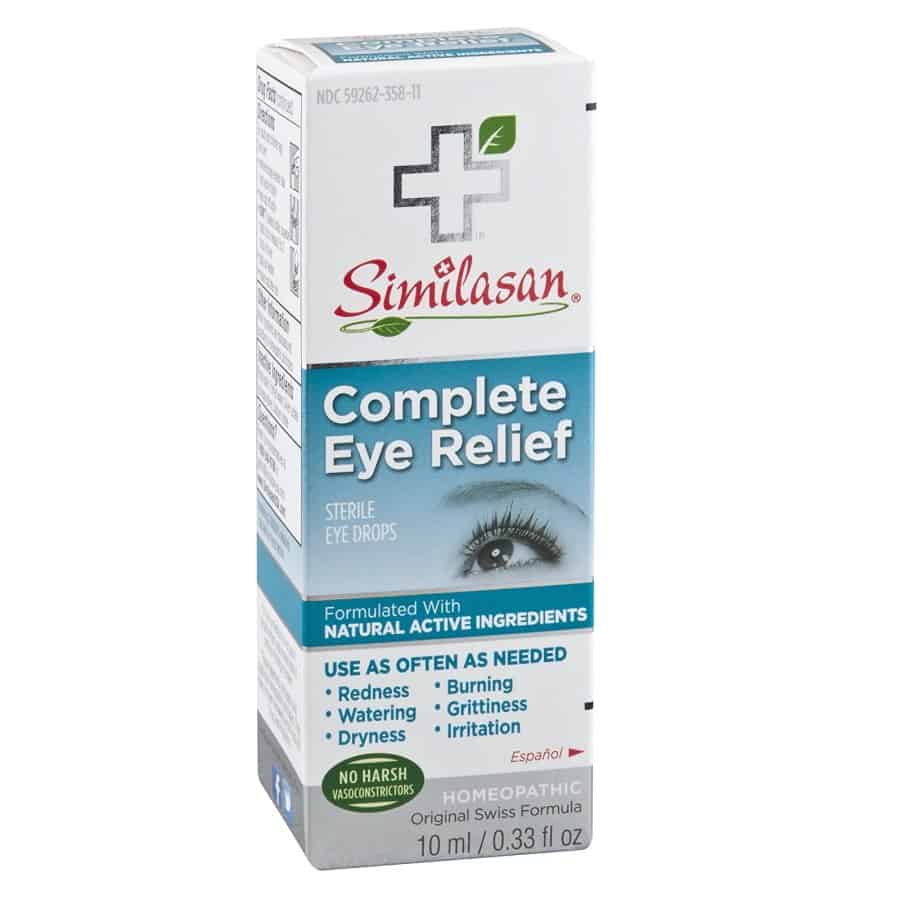
Similasan Complete Eye Relief
Smoking marijuana doesn’t have to lead to red eye problems every time. The Similasan Complete Eye Relief eye drops provide soothing comfort for redness, dryness, itching, burning, watering, and stinging.
Similasan makes great eye drops featuring a dilution of the eyebright plant instead of harsh chemicals that can worsen the redness caused by smoking cannabis.
- Multi-symptom relief
- Gentle relief
- Natural
- May not provide strong enough relief for redness
- May cause eye irritation

Visine Red Eye Comfort
Visine Red Eye Comfort Redness Relief Eye Drops relieve redness in under one minute. Use them for eye irritations due to smoke, sleep loss, prolonged screen time, and irritation from contact lenses. Its formula contains tetrahydrozoline hydrochloride to relieve red eyes.
- Affordable
- Fast-acting
- Multi-use
- Not as effective as other eye drops
- May cause a burning sensation
Eye Drops for Stoners FAQ
Why Does Smoking Weed Cause Red Eyes?
Smoking weed can lead to red eyes because it causes blood vessels in the eye to dilate. Essentially, weed smoking causes an increase in blood pressure and increased blood flow, making veins expand. This makes them look more visible in your eyes.
When Do You Put In Eye Drops: Before or After You Smoke Weed?
You can put in eye drops about 20 minutes before you smoke weed. Eye drops have active ingredients that can give you clear eyes in no time.
Is Long-Term Eye Drop Use Bad?
Generally, using eye drops every day to relieve red eyes is not recommended. At most, you should use them a few weeks at a time or less. Certain eye drops have active ingredients that can actually make your red eye problem worse and increase your tolerance for them, making them less effective over time.
How Often Should You Apply Eye Drops Per Day?
Eye drops should be applied about once or twice per day, at most. While you can use them several times per day, it is not recommended for long-term use. Always follow the manufacturer's instructions on how to apply them.
How do you get rid of bloodshot eyes quickly?
-Rest
-Apply cold compresses on closed eyelids
-Gently rub your eyelids together
-Wash your eyelids gently
-Eye drops
Does having red eyes mean a lack of oxygen?
Lack of oxygen in the eyes causes the blood vessels to dilate and appear red, which is why you frequently have red eyes when you're sleep deprived.
Does dehydration cause red eyes?
Different effects of dehydration are seen in the tissue surrounding the eye. It may result in sunken eyes and dark circles under the eyes. In addition to blurry and double vision, dehydration can also produce dry, red, and irritated eyes. Dehydration may also indicate systemic conditions that harm the eyes.
What does bloodshot eyes mean from cannabis?
When you use cannabis, the cannabinoid THC makes you feel “high.” Additionally, it damages your blood vessels, which results in red eyes. THC use causes blood vessel dilatation by lowering blood pressure. Your body's blood flow is increased by this dilation, including to your eyes.
Why does cannabis make my eyes red?
Tetrahydrocannabinol, or THC, is the main ingredient that causes red eyes from cannabis use. THC reduces blood pressure by widening blood vessels and capillaries. The eyes seem red as a result of this increased dilatation, particularly in the ocular capillaries, which increases blood flow.
Does everyone get red eyes after using cannabis?
Red eyes don't affect everyone in the same way. Individual physiologies, the quantity of THC ingested, and the mode of ingestion can all affect the response.
Are red eyes from cannabis harmful?
The typical side effect of cannabis use is red eyes, which are just the body's reaction to THC. Usually, they don't show any signs of eye damage.
How long do red eyes last after using cannabis?
Red eyes often remain as long as the primary effects of cannabis, which are frequently a few hours. However, this can vary. Factors like personal tolerance levels and the quantity of THC ingested might affect how long it lasts.
Can I prevent red eyes when using cannabis?
It can be difficult to completely avoid red eyes, but you can lessen the intensity by utilizing strains with lower THC levels or eating lesser amounts. Eye drops and watering the eyes might also be helpful.
Are there any eye drops that can help with cannabis-induced red eyes?
Yes, some of the best ones are available in the top of this article.
Is the red-eye effect stronger with certain cannabis strains?
Yes, strains with higher THC content typically have more noticeable affects on the eyes. Lower THC or higher CBD strains could not have as much of an impact.
Can edibles cause red eyes?
Yes, eating cannabis in an edible form can still result in red eyes because THC is the main ingredient, regardless of how it is consumed.
Do red eyes indicate the quality of cannabis?
THC concentration can be determined more by looking at red eyes than by overall quality. Red eyes alone aren't a good indicator of quality because different high-grade strains have different THC concentrations.
Are there long-term effects on the eyes from regular cannabis use?
There is no proof that cannabis's red-eye impact will have any lasting effects on eye health. However, you should speak with a medical expert if you already have any ocular issues.
It’s nearly impossible to hide that you’ve smoked cannabis unless you have some good eye drops. Red eyes, also known as marijuana eyes are a dead giveaway for having smoked marijuana recently.
But did you know that marijuana can have health benefits for your eyes, too?!
How Does Marijuana Affect the Eyes?
Consuming cannabis can provide significant visual health benefits beyond your bloodshot eyes. In the body, cannabis interacts with an extensive network of cell receptors and chemical signals known as the endocannabinoid system (ECS).
Cannabis compounds (cannabinoids) act similarly to naturally produced endocannabinoids and may be used to treat endocannabinoid deficiencies. High concentrations of the CB1 cannabinoid receptor can be found in the human eye and brain areas involved with visual function.
Researchers found that cannabinoid receptors regulated how the eyes responded to light.
More research needs to be done into how cannabis use affects our visual function, for better or worse. We all know that consuming cannabis can produce mild adverse effects like red eyes and dry mouth, but we are starting to uncover the many benefits it can have on our eye health.
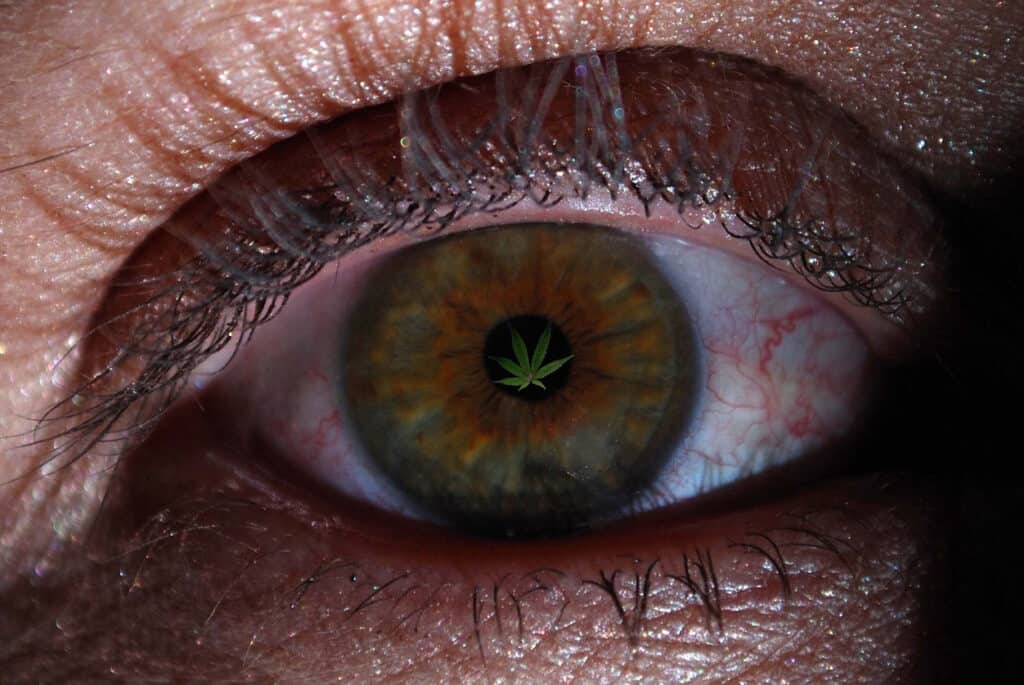
Red Eyes Also Known as Marijuana Eyes
Why does consuming cannabis cause red eyes? Cannabinoids can cause the dilation (widening) of blood vessels, thereby increasing blood flow to certain areas and causing a decrease in blood pressure. Increased blood flow to the eyes can make them look red.
Allergic Reaction
While cannabis is known for its anti-inflammatory effects, it has also been known to cause allergic reactions in some cases.
Smoking cannabis if you have a weed allergy or an allergy to smoke or molds in the bud can cause red and watery eyes, runny nose, sneezing, nausea, and hay fever.
A 2015 article from the American College of Allergy, Asthma, and Immunology described several case reports of negative reactions to cannabis.
Symptoms include allergic reactions, hypersensitivity, and anaphylaxis. Researchers noted that marijuana pollen or smoke exposure can cause symptoms of hay fever and asthma.
Improved Night Vision
Research has shown that cannabis use is associated with enhanced night vision. Jamaican fishermen have long described how smoking marijuana or taking a rum-based marijuana tincture improves their night vision and research backs this up.
A 2004 study on a small group of Moroccan subjects found that smoking Kif or synthetic THC produced dose-dependent improvements in night vision. A 2016 study on retinal cells in tadpoles found that the application of synthetic cannabinoids to the eyes made the cells more sensitive to light.
Visual Development
2015 research found that children exposed to cannabis in the womb displayed a “significant improvement in their ability to track moving objects at age four.” Researchers, however, warn parents that this does not mean cannabis has health benefits on fetal development.
The study from the University of Waterloo, University of Auckland, and Brown University found that exposure to cannabis enhanced global motion perception. In contrast, alcohol exposure was linked with lower visual processing test scores.
Glaucoma
The same dilation of the blood vessels that causes red eyes after consuming cannabis has helped glaucoma patients find relief. Glaucoma is a condition that affects the eye’s optic nerve. Over time, the disease can worsen and lead to blindness if not treated.
Research into how cannabis affects glaucoma has been ongoing since the 1970s. In a 1979 experiment on 16 test subjects, inhalation of marijuana reduced intraocular pressure associated with pain and damage caused by this condition. Patients felt pain relief for up to four hours.
A study on 18 subjects in 1980 found that marijuana inhalation was followed by elevated heart rate and decreased intraocular and blood pressure. In 2000, researchers found that a non-psychotropic cannabinoid reduced intraocular pressure for 6 hours in normotensive rabbits.
Degenerative Blindness
2014 research published in Experimental Eye Research suggests that the cannabinoid agonist HU210 may be able to delay retinal degeneration in rats with retinitis pigmentosa (RP), a rare genetic disorder that results in a loss of retina cells.
In the study, rats were given a synthetic cannabinoid over 90 days. After the testing period, researchers tested the degeneration of cells. Rats that received cannabinoid treatment had 40% more photoreceptors than non-treated rodents.
Diabetic Retinopathy
Diabetes can cause a wide range of complications, including diabetic retinopathy, a condition that damages the blood vessels in the retina. As nerve cells degenerate, a person’s eyesight can worsen. A 2006 preclinical study found that cannabidiol (CBD), a non-intoxicating cannabinoid, can offset toxicity in the retina that reduces retinal damage.
However, a 2017 study found a link between regular cannabis use and ganglion cell dysfunction, which causes damage to the retina. Keep in mind that these findings are preliminary, so more research needs to be done to provide guidance for safe cannabis use.
Marijuana Red Eyes Summary
Consumption of cannabis frequently results in a phenomenon known as “marijuana red eyes.” They are brought on by the THC found in cannabis, which causes blood vessels in the eyes to become more dilated. This makes the blood vessels more noticeable, which gives the appearance of redness to the eyes.
Other possible causes of red eyes besides marijuana include the following:
Irritation caused by smoke If you smoke cannabis, the smoke might irritate your eyes and cause them to get red.
“
There are over 300,000 jobs in the cannabis industry. CTU trained me for one of them!

Makes $24.50 @ THC +
Eye dryness is another potential side effect of cannabis usage, which can contribute to the appearance of eyes that are red and inflamed.
Allergic reactions: Cannabis allergies can manifest themselves in a wide variety of ways, including red eyes, in susceptible individuals.
You might try the following remedies to alleviate red eyes caused by marijuana:
Use a cold compress to help decrease inflammation and redness. A cold compress can help reduce inflammation and redness.
It is best to avoid smoking cannabis. If you find that smoking cannabis causes your eyes to become irritated, you may want to experiment with other means of ingestion, such as edibles or vaping.
Maintaining proper hydration by taking in an adequate amount of fluids is one way to help prevent dry eyes.
If you experience red eyes that are severe or chronic after using marijuana, you should make an appointment with a medical professional to rule out the possibility of any underlying medical disorders.
Additional prevention strategies for red eyes caused by marijuana are as follows:
Choose cannabis of a high quality since low-quality cannabis may be more likely to irritate your eyes. High-quality cannabis will not have this effect.
It is important to refrain from smoking cannabis before going to bed because doing so can cause your eyes to feel dry and itchy the following morning.
Utilize a humidifier to avoid dry eyes and help provide moisture to the air. A humidifier can assist add moisture to the air and prevent dry eyes.
Take pauses from using cannabis: If you use cannabis on a regular basis, it is important to give your eyes a chance to rest every few days by taking breaks from using cannabis.
Make an appointment with your primary care provider if you notice any redness in your eyes after using marijuana.
Final Thoughts About Marijuana Eyes
Red marijuana eyes can be an annoying side effect of marijuana use. In some cases, however, moderate cannabis consumption can be an excellent treatment for symptoms of several eye conditions.
The effects of cannabis on eye health are still not definitive, but there is promising research suggesting cannabis can be an alternative treatment option.
You don’t have to give up smoking weed to avoid having marijuana eyes. These eye drop options can provide you with instant relief from red eyes and clear eyes in just a few minutes. Keep in mind everyone may react differently to different eye drop brands. Try out a few artificial tears to determine which eye drops work best for you.

Fred Hernandez
Fred Hernandez is a highly accomplished and versatile writer, boasting an extensive background in the cannabis industry. With an in-depth understanding of various sectors including cultivators, processors, retailers, and brands, Fred's expertise spans across the entire cannabis landscape. As a prominent contributor to CTU, he consistently delivers insightful articles exploring the latest developments, news, and regulations shaping the cannabis industry. Whether it's delving into the intricacies of cannabis products, cannabis strain reviews, or providing comprehensive analyses of cannabis laws, or sharing expert insights on cannabis cultivation techniques, Fred's wealth of knowledge positions him as an invaluable writer and educator for all cannabis-related subjects.


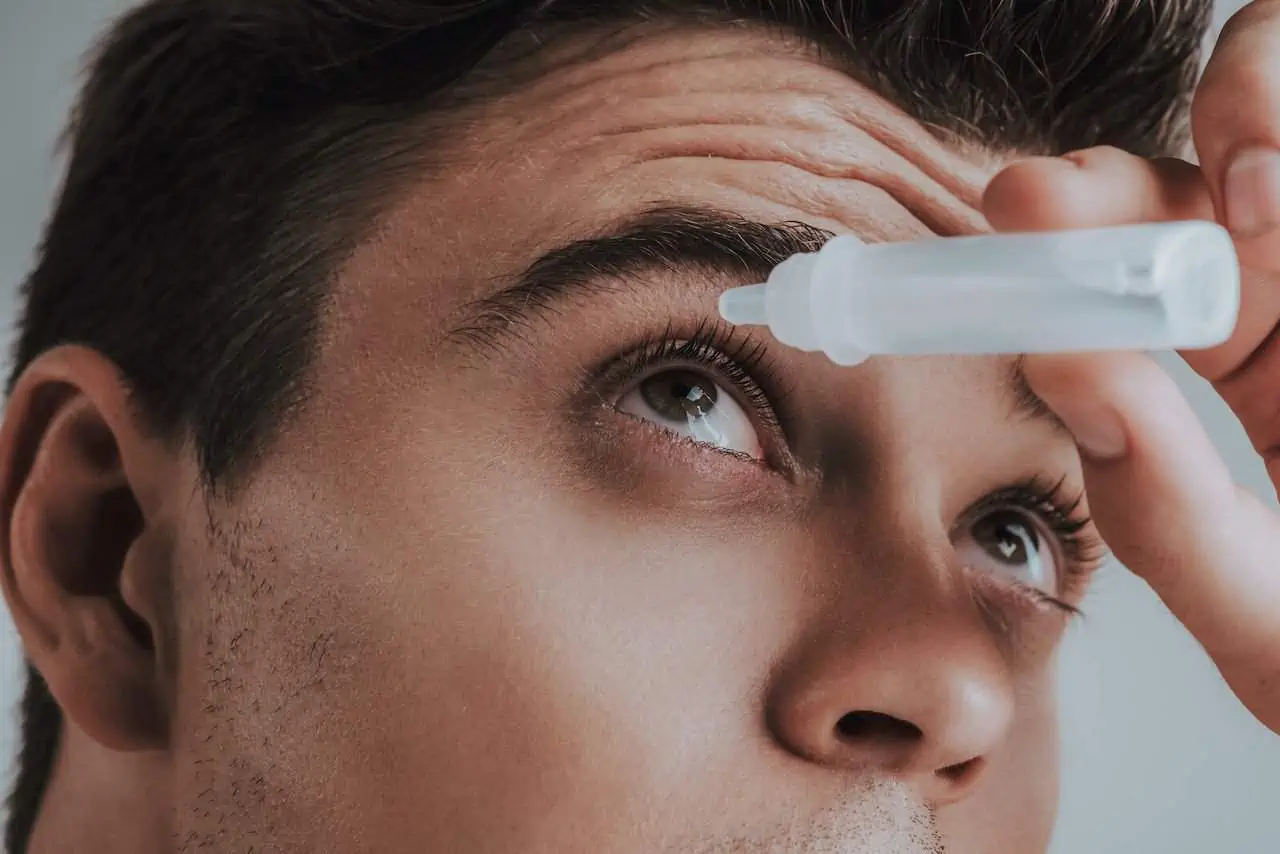









 Jeff was involved in an accident where he endured a traumatic brain injury. He had a week-long stay in ICU where brain surgeons
Jeff was involved in an accident where he endured a traumatic brain injury. He had a week-long stay in ICU where brain surgeons  100% risk free money back guarantee within 48 hours after purchase if student has not completed any of the courses or exams.
100% risk free money back guarantee within 48 hours after purchase if student has not completed any of the courses or exams.